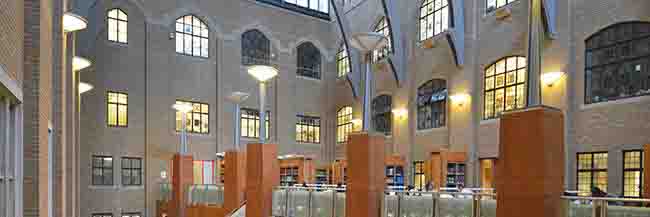
Michael Marsland
The surface of the Women’s Table — architect Maya Lin’s ’81 ARC ’86 granite gift to the Rose Walk — bears the number of women enrolled at Yale each year since the University’s inception. Though coeducation did not occur in Yale College until 1969, women were enrolled in many of Yale’s graduate schools by the 1870s.
The Yale School of Music, established in 1894, admitted women from its inception, initiating a long tradition of Yale-educated women music scholars. This history of influential women is the focus of a new exhibit at the Irving S. Gilmore Music Library.
The exhibit, titled “Musical Daughters of Eli: Women Pioneers at Yale,” will be on view in the cases outside of the music library from Feb. 25 to April 30. Archivist Richard Boursy dedicated almost a year of research to assemble and present the materials for the exhibit.
“There are many, many women who have had amazing musical careers who were students or faculty here. What I have been able to include in this exhibit barely scratches the surface,” Boursy said. “If we had bigger exhibit cases, I could have made this a much bigger exhibit.”
The exhibit honors women of many disciplines who participated in music at Yale — from performers to composers, historians to administrators. Two of the women addressed in the exhibit — Eva Judd O’Meara and Vivian Perlis — are particularly special to the music library’s history.
“O’Meara deserves attention because she is our founder, for us here at the music library. She was an amazing woman,” Boursy said. “She did not have a college education, and she didn’t need it in order to be a librarian in those days, but she was clearly a brilliant scholar and organizer.”
In the early 20th century, O’Meara held a position in Yale’s main library, the predecessor of Sterling Memorial Library. In 1917, the School of Music built Sprague Hall, one room of which was devoted to a modest music library. Yale believed that the library’s maintenance would be a small affair, Boursy said.
Yet the maintenance of the music library proved to be much more complex. In addition to her daily library position, O’Meara helped manage the music library for approximately seven years, until her position as music librarian was finally recognized in 1924. She maintained this position until her retirement in 1952, sometimes working nights and weekends to increase the accessibility of the library.
Perlis was both a librarian and harpist at Yale. In 1969, she spoke with people who were acquainted with Charles Ives, a well-known American modernist composer who studied at Yale in the 1890s. This research flourished into a long-term project, for which Perlis compiled interviews with numerous historians and composers to begin Yale’s Oral History of American Music. OHAM, which collects similar materials on a diverse body of musicians and composers, is still active and is now run by director Libby Van Cleve.
“[Perlis’] work was ground-breaking in many ways,” Van Cleve said. “She recognized the value of oral history, recorded interviews, to document musical figures when many were dubious about scholarship that was not paper-based. In addition, music scholars in the late 1960s tended to be Euro-centric, and they did not value the study of American music, popular music or most music created by peoples of color.”
According to Van Cleve, Perlis did significant work with ragtime composer Eubie Blake and jazz musician Duke Ellington in addition to her scholarship on Charles Ives and Aaron Copland.
Boursy consulted the Yale Daily News archives to find material for the exhibit. The exhibit includes an article about a concert by the a capella group The New Blue, which refers to itself as the first all-women’s organization on campus. The 1973 article describes a concert at which Yale Whiffenpoofs taunted The New Blue singers during their showcase because of their gender.
“I would have expected stuff like that to go on in 1969 or 1970, when there were all of these upperclassmen who had never seen a woman in their classes,” Boursy said. “But by ’73, you had a whole generation of Yale men who had been sitting side-by-side with Yale women and they should have known better.”
Boursy added that when he was searching the Yale Daily News archives, he found another “hair-raising article” that pertained to the Yale Glee Club’s joint concert with the Harvard Glee Club. The article describes an incident in which the Harvard Glee Club forbade the Yale Glee Club’s women from participating in the tradition of singing the Harvard Alma Mater song during the concert.
The Yale Glee Club became a mixed chorus one year after Yale College’s coeducation, following a brief experiment of having separate women’s and men’s ensembles.
The exhibit also includes a selection of six sound recordings which play on loop. These samples include a 1970 recording by The New Blue, two recordings by the Yale Glee Club before and after director Fenno Heath decided to allow women to join and spoken-word recordings, featuring O’Meara, Perlis and Van Cleve.
The exhibit can also be viewed online on the Yale Library’s exhibitions page.
Rianna Turner | rianna.turner@yale.edu .







